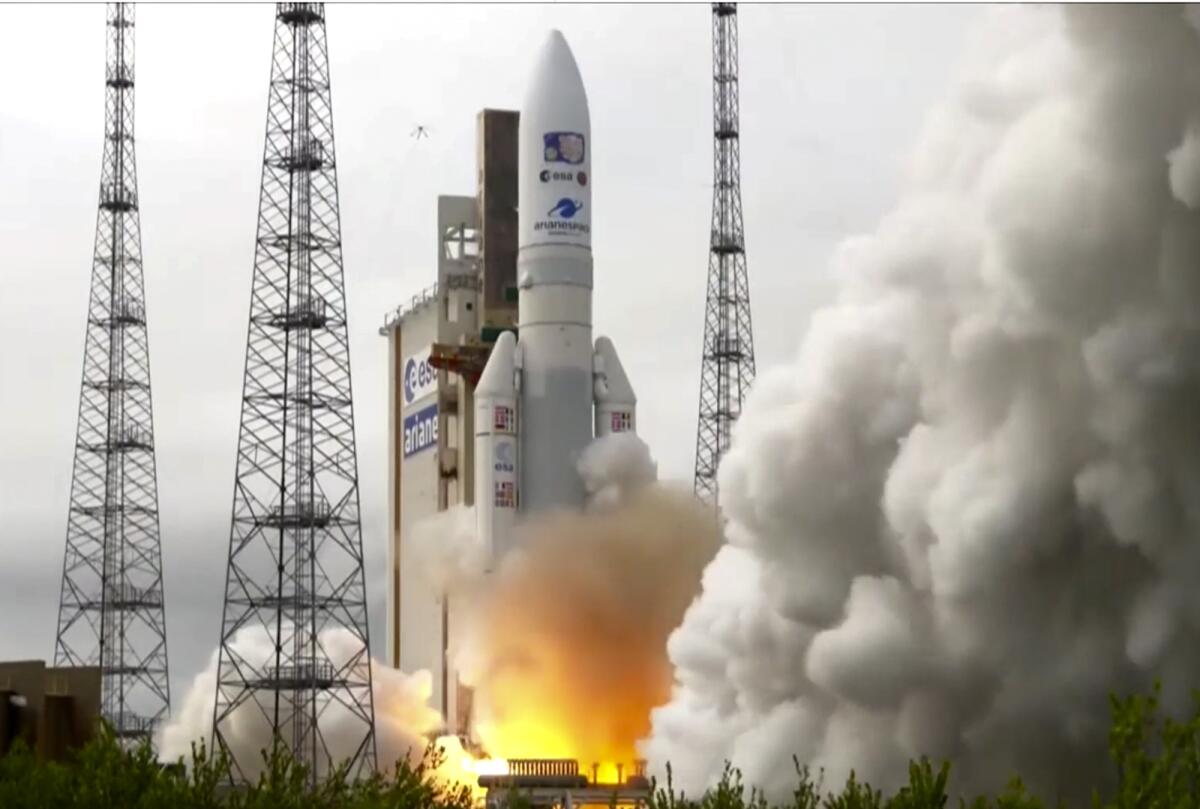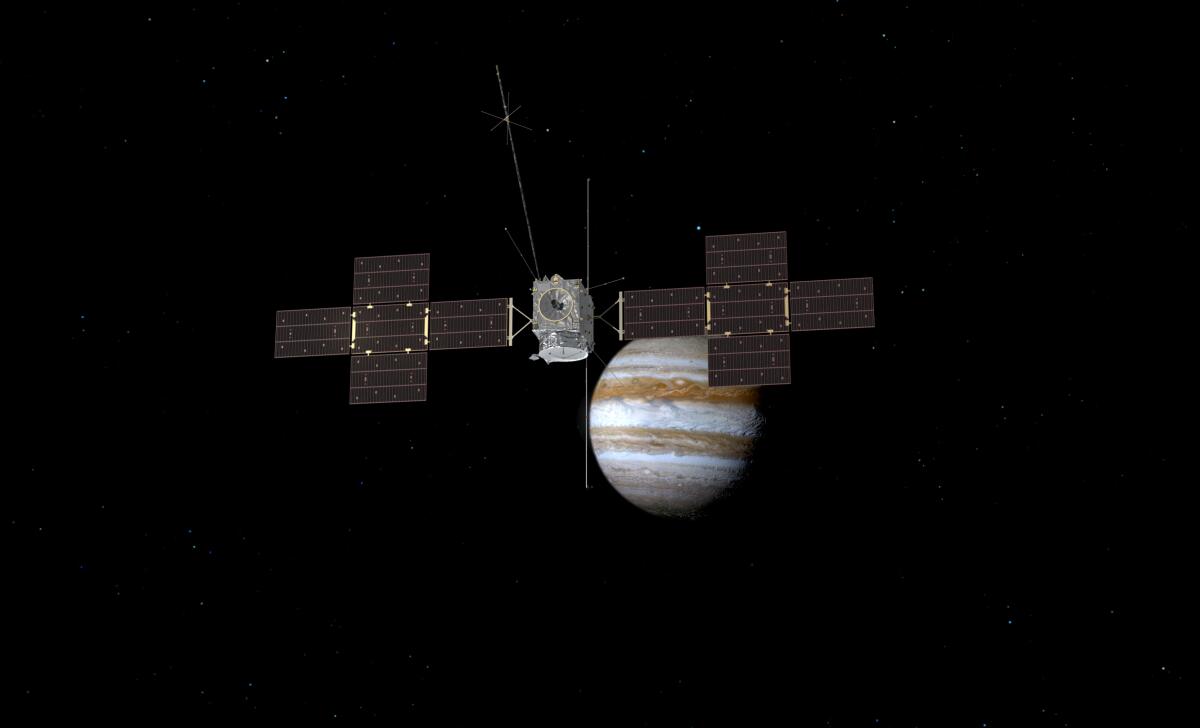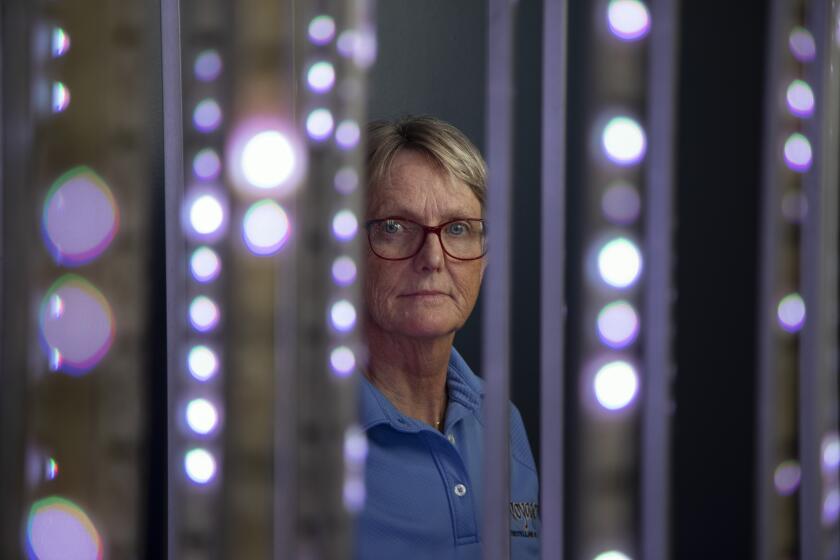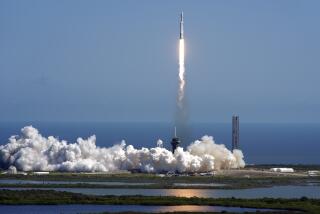European spacecraft named Juice blasts off for Jupiter and its icy moons

- Share via
A European spacecraft rocketed away from Earth on Friday on a decadelong quest to explore Jupiter and three of its icy moons that could hold buried oceans.
The journey began with a perfect morning liftoff by a European Ariane rocket from French Guiana on the northeast coast of South America. But there were some tense minutes later as controllers awaited signals from the spacecraft.
When contact finally was confirmed close to an hour into the flight, the European Space Agency’s Mission Control in Germany declared: “The spacecraft is alive!”
It will take the robotic explorer, dubbed Juice, eight years to reach Jupiter, where it will scope out not only the solar system’s biggest planet but also Europa, Callisto and Ganymede. The three ice-encrusted moons are believed to harbor underground oceans where life could exist.
Then in perhaps the most impressive feat of all, Juice will attempt to orbit Ganymede. No spacecraft has ever orbited a moon other than our own.
With so many moons — at last count 95 — astronomers consider Jupiter a mini solar system of its own, with missions like Juice long overdue.
The world’s newest and most powerful space telescope is showing Jupiter as never before, auroras and all
“This is a mission that is answering questions of science that are burning to all of us,” the ESA’s director general, Josef Aschbacher, said after the launch. “Of course, one of these questions is: Is there life out there?”
It can’t find life, “but Juice will be identifying the habitability of these icy moons around Jupiter,” he added.
The spacecraft is taking a long, roundabout route to Jupiter, covering 4 billion miles.
It will swoop within 125 miles of Callisto and 250 miles of Europa and Ganymede, completing 35 flybys while circling Jupiter. Then it will hit the brakes to orbit Ganymede, the primary target of the 1.6 billion-euro (nearly $1.8-billion) mission.
Ganymede is not only the solar system’s largest moon, bigger even than the planet Mercury, but it also has its own magnetic field with dazzling auroras at the poles.
Even more enticing, it’s thought to have an underground ocean holding more water than Earth. Ditto for Europa and its reported geysers, and heavily cratered Callisto, a potential destination for humans given its distance from Jupiter’s debilitating radiation belts, according to the Carnegie Institution’s Scott Sheppard, an astronomer who is not involved with the Juice mission.
“The ocean worlds in our solar system are the most likely to have possible life, so these large moons of Jupiter are prime candidates to search,” said Sheppard, a moon hunter who’s helped discover well over 100 of the natural satellites in the outer solar system.
Astronomers have found the most conclusive evidence yet that a large watery ocean lies beneath the surface of Jupiter’s moon Ganymede.
The spacecraft, about the size of a small bus, won’t reach Jupiter until 2031, relying on gravity-assist flybys of Earth and our moon, as well as Venus.
“These things take time — and they change our world,” said the Planetary Society’s chief executive, Bill Nye. The Pasadena-based space advocacy group organized a virtual watch party for the launch.
Belgium’s King Philippe and Prince Gabriel, and a pair of astronauts — France’s Thomas Pesquet and Germany’s Matthias Maurer — were among the spectators in French Guiana. Thursday’s launch attempt was nixed by the threat of lightning.
Juice — short for Jupiter Icy Moons Explorer — will spend three years buzzing Callisto, Europa and Ganymede. The spacecraft will attempt to enter orbit around Ganymede in late 2034, circling the moon for nearly a year before flight controllers send it crashing down in 2035, later if enough fuel remains.

Europa is especially attractive to scientists hunting for signs of life beyond Earth. Juice will keep its Europa encounters to a minimum, however, because the radiation so close to Jupiter is intense.
Juice’s sensitive electronics are encased in lead to protect against radiation. The 14,000-pound spacecraft also is wrapped with thermal blankets — temperatures near Jupiter hover around minus-380 degrees Fahrenheit. And its solar panels stretch 88 feet tip to tip to soak in as much sunlight as possible that far from the sun.
Late next year, NASA will send an even more heavily shielded spacecraft to Jupiter, the long-awaited Europa Clipper, which will beat Juice to Jupiter by more than a year because it will launch on SpaceX’s mightier rocket. The two spacecraft will team up to study Europa like never before.
NASA has long dominated exploration of Jupiter, beginning with flybys in the 1970s by the twin Pioneers and then Voyagers. Only one spacecraft remains humming at Jupiter: NASA’s Juno, which just logged its 50th orbit since 2016.
Keeping in touch with NASA’s two aging Voyager spacecraft is getting harder to do as they get farther away and their power sources dwindle.
Europe provided nine of Juice’s science instruments, with NASA supplying one.
If Juice confirms underground oceans conducive to past or present life, project scientist Olivier Witasse said, the next step will be to send drills to penetrate the icy crusts and maybe even a submarine.
“We have to be creative,” he said. “We can still think it’s science fiction, but sometimes the science fiction can join the reality.”








